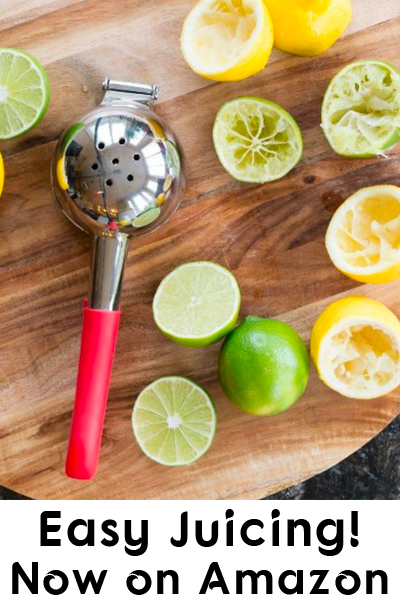How Many Apples Are in a Pound or Cup
Many salad and dessert recipes call for "1 cup of mashed apples" or "1 cup of chopped apples" or even "1 cup of sliced apples" but it is not always straight forward to decipher actually how many apples are in a cup. In order to help make cooking easier we did some experiments to help tell you exactly how many apples you need to buy.
To answer How many apples in a cup we went to the grocery store to play in the produce section. After surveying the fruit we decided to use medium apples for our calculations and discovered that 1 pound of apples equals 3 to 4 medium apples. We bought a couple pounds of medium apples and headed home to start coring our stash.
We then started chopping and found it took 1.5 cored apples to reach the 1 cup mark. Next we mashed the apples to determine how many apples were needed to measure a cup. We found when mashed it took 2 whole apples. However, when measuring for 1 cup of sliced apples, just 1 apple did the trick.
Did you know that apples are actually a member of the rose family of plants? Even though the crabapple is the only apple native to North America, the red delicious apple is the most widely grown variety in the U.S. Ever wonder why apples float in water? They are made up of 25% air!
Next time your recipe calls for a cup of mashed or chopped apples you'll know that you need to purchase 2 apples at the store. And how many apples are in a cup of sliced apples? You only need to buy 1 apple. You can also use our conversion tool below for any custom "how many apples in a..." measurements you need. If you are coring a lot of apples by hand you should definitely look into getting a good apple corer. Either the ORBLUE Stainless Steel Apple Corer or the OXO Good Grips Corer are inexpensive options that will hold up well and greatly speed up the process.

Custom Conversions for Apple
One Apple Equals
- There is ½ Cup (118 mls) of Cored and Mashed Apple in a Apple
- There is ¾ Cup (177 mls) of Cored and Chopped Apple in a Apple
- There is 1 Cup (237 mls) of Cored and Sliced Apple in a Apple
of
You need 2 Apples
Want a Fancy Cocktail?
What Are Apples?
Apples are a popular bright-colored, sweet tasting and crunchy to bite into fruit. Apples are widely grown around the world. They belong to the Rosaceae family, along with pear and peach trees.
Apples have small black seeds in its core which are generally not eaten. In the United States apples are in their prime from July thru November.

Are Apples a Fruit or Vegetable?
Apples are edible fruits that grow on trees, apple trees.
Ever heard the saying ‘an apple a day keeps the doctor away’? Eating an apple each day won’t really keep the doctor away, but following a healthy eating plan most of the time, which includes apples, can actually prevent many diseases!
What Are the Types of Apples?
There are so many different varieties, but apples are usually categorized as 'table', 'cooking', or 'cider' apples.
'Table' apples are enjoyed raw and are quite sweet compared to other types. This group includes Red Delicious, Fuji, Cortland and Gala.
'Cooking' apples are used for just that (cooking), they're slightly bigger and more bitter than those eaten raw. Some of the common ones found in the store are Bramley, Granny Smith, Gravenstein, and Jonathan.
'Cider' apples have been developed specifically for making apple cider. This fruit is usually dry and bitter, which doesn't make them a popular choice to eat raw. But because of their high acid levels and sugar content, they are good for alcohol production! A few examples of cider apples are Sweet Alford (sweet), Backwell Red (sharp), Brown Snout (bittersweet) and Foxwhelp (bittersharp).
Because apples are so versatile, it can be difficult to decide whether you need a 'table' or 'cooking' apple if the recipe doesn't specify. The general rule of thumb is to use 'cooking' apples if you prefer a moist, softer textured dish and 'table' apples if you want your apples to retain their shape.
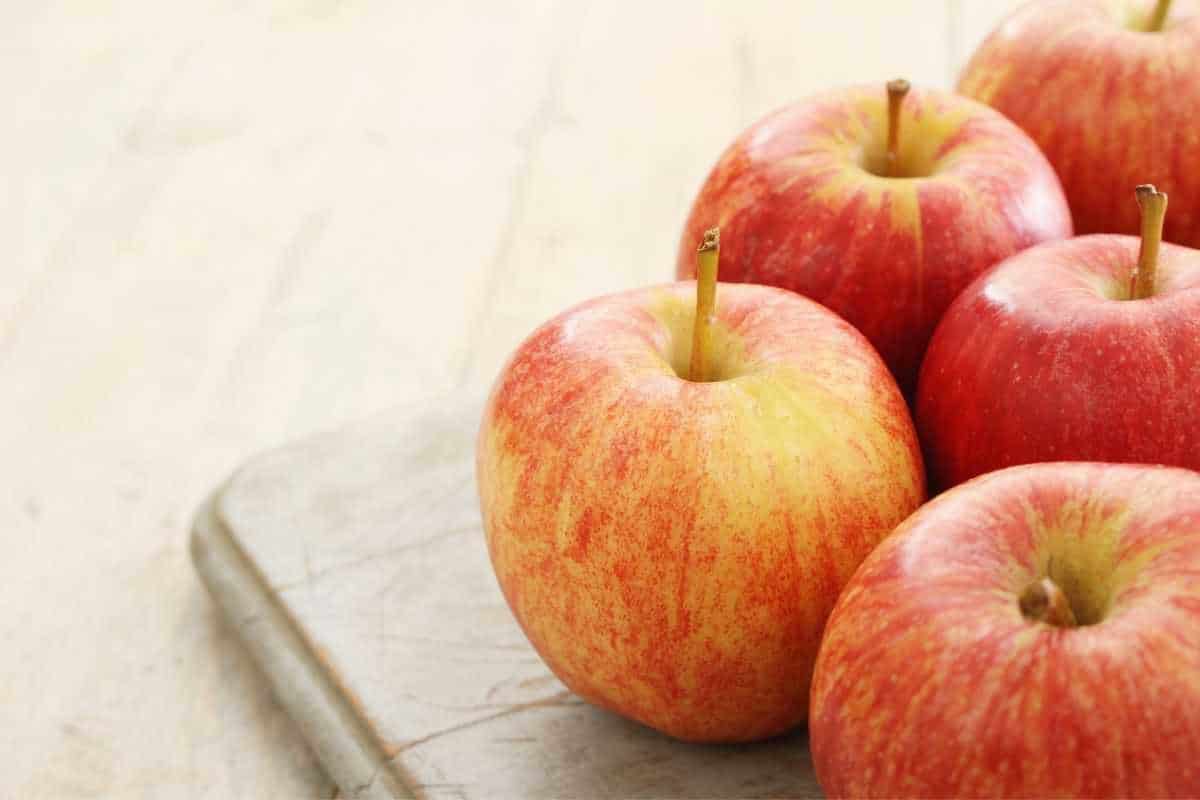

What Do Apples Look and Taste Like?
Apples are plump and succulent fruit and come in many different shades of greens, reds and yellows. They’re mostly round in shape, around 2-4 inches (5–10 cm) in diameter, but the different varieties do vary in size and shape.
A fresh apple feels firm, has bright skin and smells pleasant. The skin is crunchy but tasteless, and easy to bite into. Apples are sweet and juicy, some varieties a little sour, others even slightly bitter, but they have a distinct taste that only an apple can have!
What Are Apples Good For and Used In?
Apples are a popular and healthy fruit, containing antioxidants, vitamins, dietary fibre, and loads of other nutrients.
You can eat them raw, right off the tree. They also pair especially nicely with nut butter for a super healthy snack. You can mash them into applesauce, chop them up for salads, bake them whole with cinnamon, dry them for a snack chip, use them in smoothies, juice them for a refreshing beverage or even turn them into candy apples - the list is almost endless!

What are Good Substitutes for Apples?
There are many substitutes to choose from if you’d like to keep the consistency, taste or even texture of the dish relatively similar.
Pears and peaches are popular substitutes for apples in desserts. Papaya is recommended in salads.
Applesauce can be replaced with pineapple puree, or even pureed apricots, prunes and bananas, just be careful with the amounts used as some of the fruits have a stronger taste compared to apples.
Can I Feed Apples to My Dog, Cat, or Other Pet?
Yes you can feed your pet apples, but not the stem, leaves, and seeds, which contain small amounts of cyanide.
Don’t hesitate to contact your veterinarian or animal poison centre if your pet accidentally consumes any of these! Small amounts of cyanide might not harm us but it could harm a small pet.
Do Apples Give You Gas?
There is a significant amount of sorbitol in apples, which affects each person differently, but can result in gas and bloating. Ingested in large amounts, it may cause diarrhea, especially in children.
How to Store Apples
How Long Do Fresh Apples Last at Room Temperature?
Whole apples will usually keep 5 to 7 days at room temperature; longer than that and they will start shriveling up and lose their flavor and crispiness. Apples continue to ripen after they’ve been picked (especially at room temperature), so don’t buy fully ripened apples unless you’re planning on eating them within a day or so.
Ensure the apples are firm and steer clear of soft spots! Treat apples like you would eggs: don’t damage their skins if you want them to last long! Apples with damaged skin will release ethylene gas, making your apples will rot faster. Apples will last much longer if stored in the refrigerator.
How to Store Cut Fresh Apples
Cut and sliced apples will last for 3-5 days in airtight containers or Ziploc bags in the refrigerator. Sliced apples do turn brown quite quickly once cut and the flesh is exposed to the air. You can easily prevent this from happening by doing one of the following:
● Soak apple slices in salted water for a few minutes, rinse well before storing. Browning can be prevented for up to a week.
● Toss cut apples in lemon juice. It will give the apples a lemony flavor, but it will only prevent browning for a few hours. It is best to use this method if you know the apples will be eaten promptly.
● Soak cut apples in lemon-lime type soda for a few minutes. You don't need to rinse the apples but drain them well so they don't become soggy in the refrigerator. This will prevent browning for a few days.

How to Store Apples in the Refrigerator
Whole, unwashed, and individually wrapped apples will keep for 6 - 8 weeks in the refrigerator. Apples love humid conditions, and wrapping them individually in damp towels will help keep the air moist.
Otherwise keep them in the crisper drawer, in a plastic bag with holes in it. Just don't store other vegetables in the same drawer; apples absorb flavors easily and they give off ethylene gas, which can speed the decay of the other produce! Unless of course you enjoy onion flavored apples...
There is indeed some truth to the old saying that "one bad apple spoils the bunch." By individually wrapping your apples, one bad apple is less likely to spoil and cause decay in your other apples and produce.
Can You Freeze Apples and if so, How?
Apples can absolutely be frozen. Frozen apples are much softer after being thawed, which makes them popular for smoothies and baking with.
To freeze whole apples, simply wash and dry them thoroughly, place them on a baking tray and freeze for a few hours or overnight. Once frozen, you can transfer them to freezer bags.
To freeze sliced apples, wash and dry the apples thoroughly, then peel, core and slice them. Toss the slices in lemon juice or soak them in saltwater to prevent them from browning, rinse well and place them in a single layer on a baking tray. Freeze the slices for a few hours or overnight, and once frozen, store sealed in freezer bags.
Frozen apples usually keep for about 3 to 6 months in the freezer, any longer will result in loss of flavour and texture.
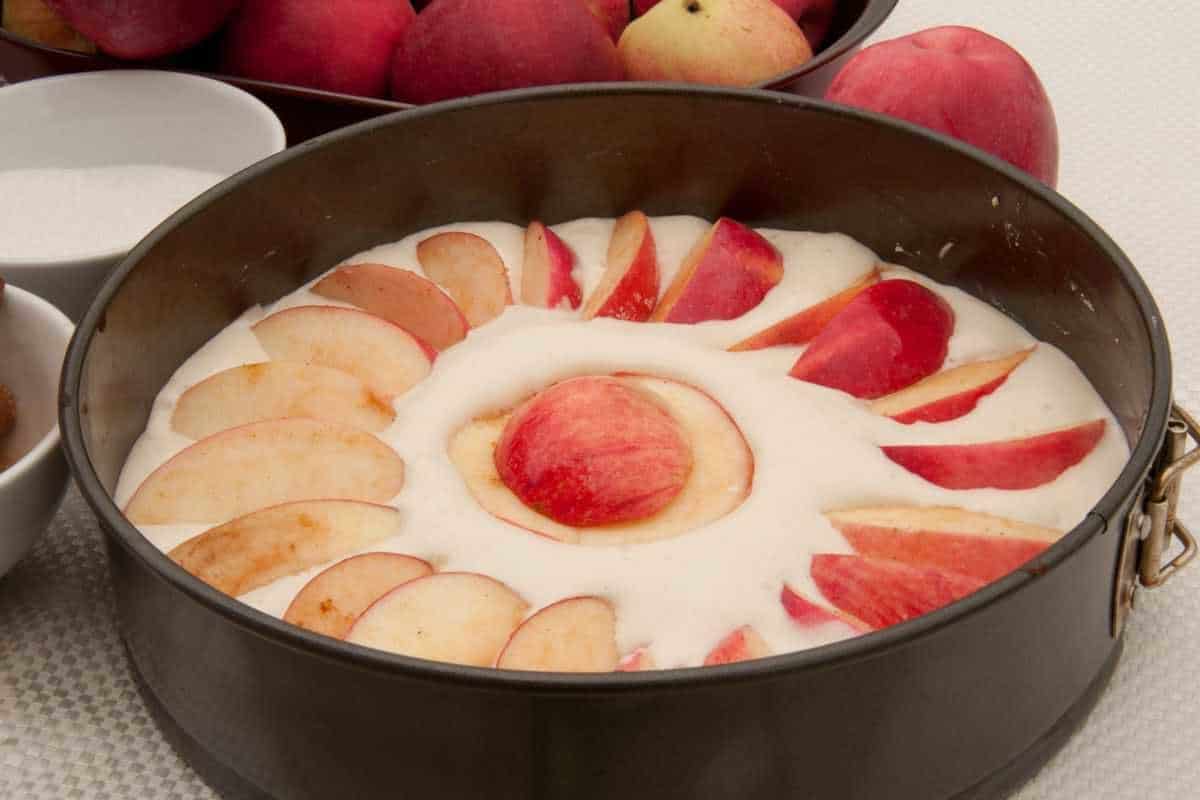
How to Cut Apples
Cutting apples doesn't require any special tools, just a paring knife and a cutting board will do the trick. Before cutting into slices or cubes, it is best to wash your apples, and core them.
Remember, exposed apple flesh will start to discolor once it comes in contact with the air. There are several different ways to help mitigate this from happening.

How to Clean Apples
Here are 3 ways to clean your apples:
● Scrub your apples under running hot water, with either a vegetable brush or a clean cloth, to get any dirt and bacteria off the skin.
● Soak your apples for 15 minutes in a solution of one teaspoon of baking soda and two cups of water, then rinse them well.
● Mix a third cup of vinegar with a cup of water. Spray or wipe the vinegar/water solution on your apples, rinse thoroughly.
Can I Eat the Skin of Apples or Should I Peel Them First?
Yes, you can eat the skin! Apple skins are chock full of goodness and contain fiber, vitamins, minerals, and antioxidants. So, to get the most out of an apple, eat both the inside flesh and the skin!
However, before you eat the apple with the skin, make sure it's been washed and free from pesticides and bacteria. Farmers sometimes spray produce with edible wax to prevent moisture loss while in transit (and to make the produce appear more attractive). You can wash waxed apples with lukewarm water and a vegetable brush before eating.
The easiest way to peel an apple is with a vegetable peeler, but you can also use a sharp knife. Prepare a cutting board and cut the top and bottom of your apple away to create a flat surface for the apple to sit steady. Peel or cut the skin off in strips, making sure you cut away from your body, until the skin is completely removed.

How to Slice Apples
There are a few ways to cut apples, which include cutting out or around the core, slicing them, dicing them, julienne cutting them (so they resemble match sticks), to mention a few.
But simple slices are the easiest to create and most used:
Start by washing and drying your apple thoroughly.
Place the apple with the stem facing up on a cutting board. Slice down one side of the apple, avoiding the core. Repeat the process on the other side of the apple, discarding the core. Place the pieces flat side down and slice horizontally into slices, as thick or thin as you please.
Apple stems, leaves and seeds are poisonous, so remember to toss them!

How to Cube Apples
Wash and dry your apple thoroughly. Place it with the stem facing up on a cutting board. Slice down one side of the apple, avoiding the core. Repeat on the other side of the apple, discarding the core.
Place the pieces flat side down and slice horizontally into slices, as thick or thin as you please, then slice the slices crossways into cubes, as big or small as you please.

How to Dice Apples
Wash and dry your apple thoroughly. Place it with the stem facing up on a cutting board. Slice down one side of the apple, avoiding the core. Repeat on the other side of the apple, discarding the core. Cut the pieces crosswise into thick slices, then stack a few slices on top of each other and cut them into small cubes.
Try to cut the pieces the same size as other diced ingredients in your dish to make it easier to eat. If you want the apple to retain some of its shape after cooking, dice it into large pieces. If you want it to be soft and "disappear" in the dish, dice it into small pieces.
How to Mash or Puree Apples
Apple puree is a delicious way to use up excess apples!
Wash and dry your apples thoroughly. Apple stems, leaves and seeds are poisonous, so remember to discard them!
Peel the apple, then slice it into manageable chunks. Transfer the chunks to a large pot, adding 1/4 cup of water. Bring to the boil. Once boiling, turn the heat down and simmer for 15 minutes.
Another option is to bake them at 375°F (190°C) for 30 to 45 minutes, until cooked through and soft, but not overcooked and mushy.
Remove and / or drain the apples, and if using a food processor, blend the cooked apples until smooth. For a chunkier consistency, mash the apples with a fork or potato masher.
Pureed apples can be frozen, and although freezing the puree won't affect the taste, it might discolor slightly by turning a bit brown.
To freeze, make sure the puree has completely cooled down. Pour the apple puree into an ice cube tray. Leave in the freezer for a few hours or overnight until frozen. Remove the frozen puree cubes from the ice cube tray and place them in a freezer bag. The apple puree will keep for around four months in the freezer.
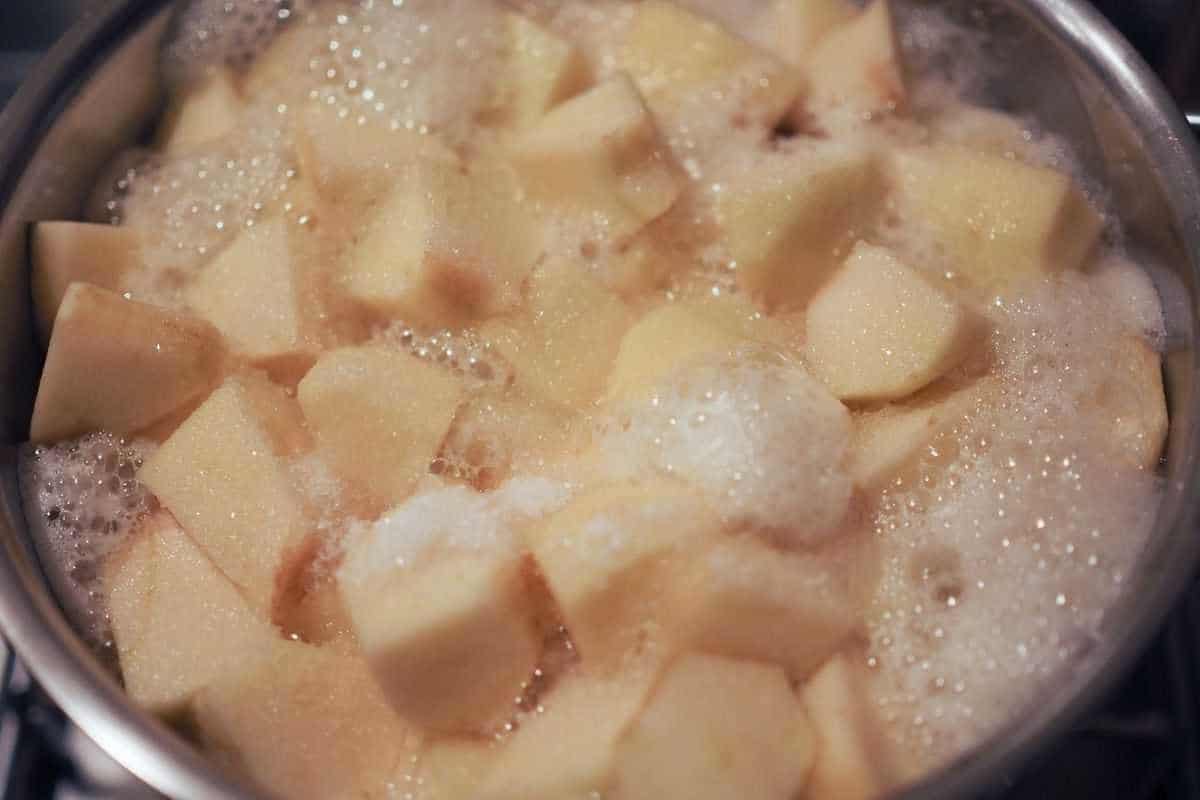
How to Grate or Shred Apples
Wash and dry your apples thoroughly. Apple stems, leaves and seeds are poisonous, so remember to toss them!
You will need a box grater and cutting board to shred your apples. Hold the apple by the top and bottom of the core and grate it on the large holes of the grater, dropping the shreds on the cutting board. Rotate the apple after reaching the core and continue grating until you have only the core left.
How to Make Apple Juice
To make about 2 quarts of apple juice, you will need 18 apples.
Wash and dry your apples thoroughly. Slice them into manageable sized chunks, discarding the core, stem and leaves. Place the apple chunks in a pot, and fill it with water so they are just covered. Boil for 20 - 25 minutes until soft.
Slowly pour the mixture into a mesh strainer and mash with a fork. The juice will leave behind a mushy residue that you can use to make puree.
Once the juice has cooled, you can add flavorings like cinnamon or sugar as needed.
When you make your juice, you break down the apple, which will expose it to air, and it will oxidize / turn brown. Adding lemon won’t make much of a difference, so it’s best to drink it the same day you prepare it.
Do Apples Have Seeds and Can I Eat Them? How do I Remove the Seeds?
Yes apples do have seeds BUT they contain cyanide. You're very unlikely to eat enough apple seeds to poison yourself, so don't worry too much if you swallow one on the odd occasion. Swallowing whole seeds won't cause harm because they have a coating which protects them from digestive enzymes, causing them to pass through your digestive system undamaged. But chewing and swallowing a large number of apple seeds a one sitting could be dangerous.
Apple juice and smoothies often contain whole crushed apples, including the core and seeds. Because the apple seeds get crushed during the juicing process, they could release some cyanide, so it's definitely advised to core the apple before juicing it.
Here are two easy ways to core an apple:
• Use an apple corer: Push it through your apple, twist it, then lift it back out to remove its center.
• Use a paring knife: Cut the apple into quarters or halves, making sure not to cut into the cores, discard the cores.

Can I Eat Apple Greens?
Apple stems, leaves and seeds contain cyanide and should not be eaten.
Apple blossoms have a delicate floral taste and can be cooked or eaten raw, but consume with caution and in moderation, as they may also contain cyanide.
- What Are Apples?
- Are Apples a Fruit or Vegetable?
- What Are the Types of Apples?
- What Do Apples Look and Taste Like?
- What Are Apples Good For and Used In?
- What are Good Substitutes for Apples?
- Can I Feed Apples to My Dog, Cat, or Other Pet?
- Do Apples Give You Gas?
- How to Store Apples
- How Long Do Fresh Apples Last at Room Temperature?
- How to Store Cut Fresh Apples
- How to Store Apples in the Refrigerator
- Can You Freeze Apples and if so, How?
- How to Cut Apples
- How to Clean Apples
- Can I Eat the Skin of Apples or Should I Peel Them First?
- How to Slice Apples
- How to Cube Apples
- How to Dice Apples
- How to Mash or Puree Apples
- How to Grate or Shred Apples
- How to Make Apple Juice
- Do Apples Have Seeds and Can I Eat Them? How do I Remove the Seeds?
- Can I Eat Apple Greens?
How to Store Apple
General How to Store Apple Info
Refrigerate apples separately from vegetables because apples naturally release small amounts of ethylene gas that can damage lettuce and other produce.
Cut apples quickly turn brown; the use of ascorbic acid (vitamin C) is a common and effective treatment. Ascorbic acid can be purchased where canning supplies are sold; follow the directions on the package.
Short Term Apple Storage
Apples keep best in your refrigerator, preferably in the crisper drawer or in an unsealed plastic bag.
Cut or sliced apples should be covered and refrigerated if they are not eaten within 2 hours of preparation; this reduces browning and maintains quality.
Apple Long Term Storage
Do not try to store apples with bad spots or worm holes. Wrap each apple in a piece of newspaper; place several wrapped apples together in a plastic bag tied with a string or twisty. The plastic bag keeps the apples from drying out and the paper helps absorb moisture from any apple that may spoil. Store the plastic bags of apples in boxes in a cold storage area of 35 to 40°F (1.7 to 4.4°C). Apples stored this way will stay crisp and flavorful throughout the winter.
Freezing apples for use in future uncooked desserts, a syrup pack is recommended. Apples for cooked desserts can be prepared with either a sugar pack or unsweetened dry pack. In either case, apples can be stored in rigid plastic containers, plastic freezer bags, or glass jars made specifically for freezing. Apples will maintain a high quality for 8 to 12 months at 0°F (-17.8°C).
Apples are high in acid which inhibits the growth of bacteria, making them ideal candidates for canning.
Apples are considered excellent candidates for dehydrating. Dried apples can be stored in sealed plastic bags or airtight containers. The apples color, flavor, aroma, and nutritive value will start to decrease after a year. Well wrapped dried apples can be frozen; the quality and flavor will last for 2 years.
Apple Recipes
Sous Vide Cranberry Apple Pie Recipe
 Sous vide cranberry apple pie uses cranberries to round out the flavors, and sous vide to ensure the perfect consistency and a golden brown crust.
Sous vide cranberry apple pie uses cranberries to round out the flavors, and sous vide to ensure the perfect consistency and a golden brown crust.
Apple Pie with a Sous Vide Yellow Delicious Filling and an Embossed Crust Recipe
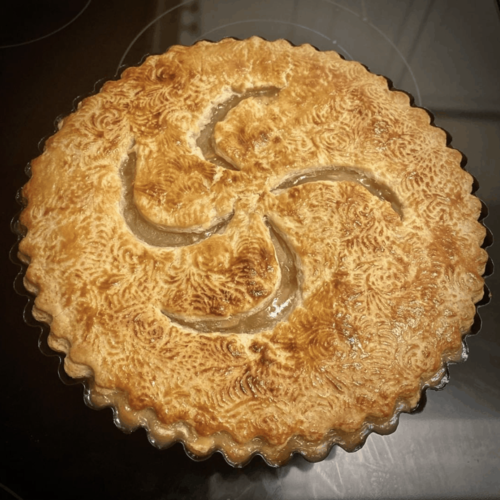 Why sous vide apples before baking them into a pie? There are several reasons but the absolute control over the texture is the biggest one!
Why sous vide apples before baking them into a pie? There are several reasons but the absolute control over the texture is the biggest one!
Sous Vide Apple Cranberry Slab Pie
 Using the sous vide method to cook this apple cranberry filling keeps the apples nice and tender without the risk of them turning into apple sauce.
Using the sous vide method to cook this apple cranberry filling keeps the apples nice and tender without the risk of them turning into apple sauce.
Looking for Something a Little Different?
Popular Vegetable Conversions
How Many Bananas in a CupHow Much is a Bunch of Sage
How Much Juice in a Lime
How Much is a Bunch of Thyme
Volume of an Egg
How Much Corn is on an Ear
How Many Bread Crumbs in a Slice of Bread
How Much Is A Bunch Of Cilantro
How Much Is In A Bunch Of Basil
How Much Shredded, Sliced, Or Chopped Is In A Carrot
How Much Is A Pound Of Cheese Cubed Or Shredded
What is the Produce Converter?
One of the biggest hassles when cooking and working in the kitchen is when a recipe calls for "the juice of 1 lime" or a similar measurement. Often times when cooking people use bottled juices, pre-sliced vegetables and other convenient cooking time savers. Produce Converter will help you convert the "juice of 1 lime" and other similar recipe instructions into tablespoons, cups and other concrete measurements.
Produce Converter can also be used to figure out how many vegetables to buy when you need, for instance, "A cup of diced onion." You can use our easy conversion tool to figure out exactly how many onions you need to buy at the store in order to end up with the amount you need for your cooking.
We hope you enjoy Produce Converter and if you have any suggestions for how we can improve it and make your cooking easier please let us know.

